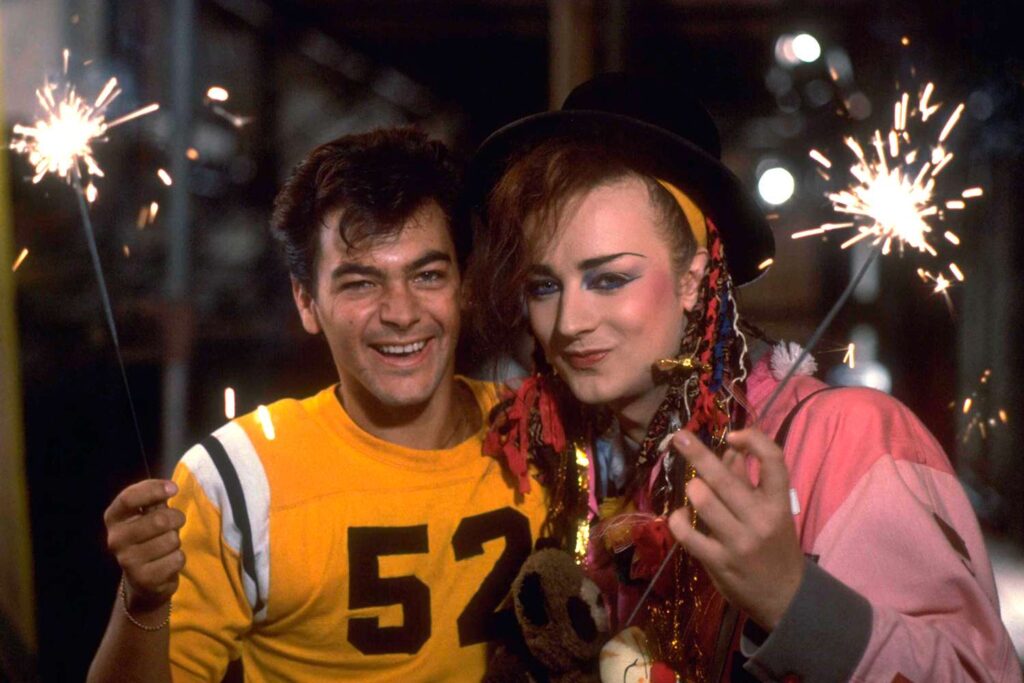NEED TO KNOW
It started with a picture on the wall.
Boy George was on date with Les Daley, the editor of My Guy magazine, and during a pit stop at Daley’s office, George spotted a photo of Jon Moss, future drummer of Culture Club, on the wall. The rest is history that’s being revisited in the new documentary Boy George & Culture Club, premiering June 5 at the Tribeca Festival. The film, directed by Alison Ellwood, is screening at Tribeca through June 12.
All four members of Culture Club participated in the documentary: George, Moss, bassist Mikey Craig and guitarist Roy Hay. In the beginning, there was just George (real name: George O’Dowd), Craig and a guitarist named John Suede. They needed a drummer. And along came Moss.
“I rang him up, and we had the most bizarre conversation,” George, 63, recalls of his first conversation with Moss in 1981. “I was like, ‘You know, I’m starting this band, and we got a rehearsal on Sunday at Elephant and Castle. Do you want to come?”
Gary Gershoff/Getty
“He turns up — I didn’t think he was going to come,” George continues. “He turns up in this, like, you know, very expensive Golf Convertible with this stinking and beautiful perfume, with his earrings in, and yeah, it was, it was love at first sight, basically.”
Moss, 67, then slowly walks through a back door to tell his side of the story. “He was a beautiful, exotic creature,” he says of George. “Really attracted to him, like a crush, you know, although I’d never had a relationship with a man before, and I was absolutely smitten.”
Karwai Tang/WireImage
George picks up the story: “When I met John, John was so kind of, almost a bit flirtatious and provocative. He wasn’t some, like, uptight straight guy that was, like, lured into some evil world by me. I mean, he was as much a part of it as I was. You know, there was an instant flirtation between us.”
Things heated up pretty quickly. “So we had this sort of rehearsal, and I think I put my hand on his knee, and he put his hand on my knee, and it was like, ooh, exciting. It’s very exciting,” Moss says.
“If you’re lucky enough in your life to have a moment, it must be like having fate,” he adds. “There was a moment in my life when I thought, ‘I don’t know what’s happening here, but something’s happening.’ I just remember it was like… I knew my life was gonna change.”
Craig recalls noticing “an interaction” between the two during that first rehearsal. “By about the third rehearsal, we’re packing up the gear ready to go home, and Jon says, ‘I kind of like George,’ ” Craig recalls in the documentary. “And I said, ‘No, no, you can’t. You can’t do this.’ I said, ‘It’s not gonna work. You’re gonna ruin the band. It’s gonna, it’s gonna end before we begin.’ And John turned to me and says, ‘It’s too late. I’ve already slept with him.’ ”
Steve Rapport/Getty
It didn’t ruin the band — at least not at first. After replacing Suede with Roy Hay and becoming Culture Club (a nod to the four distinct backgrounds of the members: George is Irish, Moss is Jewish, Craig is of Jamaican descent and Hay is and Englishman), the band would go on to dizzying success. Their first two albums, 1982’s Kissing to Be Clever and 1983’s Colour by Numbers, were global hits that spawned a string of massive hit singles, including “Do You Really Wanna Hurt Me” and “Karma Chameleon.” At the 1984 Grammys, they won Best New Artist over Eurythmics.
Two years later, amid declining sales, friction in the band, the end of George and Moss’s tumultuous relationship, and George’s descent into addiction, Culture Club split up. They reformed in 1998 for four years and reunited again in 2011. They remain active to this day, though without Moss, who departed in 2018 and sued the band for tour income he claimed was owed to him after he was allegedly “expelled” from the group by the band’s manager. The case was settled out of court in 2023 for a reported £1.75m.
Mike Windle/Getty
Although all four contributed to the new documentary, they each appear in separate interviews. So any hard feelings?
“I’ve actually never been onstage with him and felt like I didn’t want to be there,” George says near the end of the documentary. “So somewhere in there, there’s love.”
“A peculiar type of love,” he says with a laugh. “But there is definitely love in there.”

